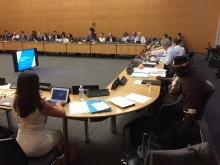Prevention strategies for antimicrobial resistance

One of the main issues discussed, and which TUAC was specifically invited to make contributions on, was economic evaluation of prevention strategies for antimicrobial resistance (AMR).
Antimicrobial resistance is an increasingly serious phenomenon, where diseases causing micro-organisms develop the capacity to resist the effects of medicines hitherto used to successfully treat them. This includes antibiotic resistance, which is one of the most common forms of AMR.
The OECD Health Committee noted that the growing incidence of AMR is a matter of global health concern. It has resulted in worsened outcomes for infectious diseases, and also jeopardises modern medical procedures such as organ transplants, chemotherapy, and invasive surgery, which rely on effective antimicrobials.
While the phenomenon is partly as a result of mutation, occurring spontaneously as natural selection, a major reason for increasing development of resistance mechanisms to drugs by pathogenic microbes is the improper use of antimicrobial drugs. As the health committee observed: “Antimicrobials are some of the most overused and misused medications due to their low cost, perceived effectiveness, and lack of side effects.” This includes antimicrobial use in animals which have been linked to human disease.
Some proposals of prevention strategies include: stewardship programmes, delayed antimicrobial use, improved hand hygiene, and mass media campaigns. PSI/TUAC shared the concerns of the OECD Health Committee and supported its proposed strategies, with suggestions for strengthening them.
One suggestion is to entrench social dialogue in the formulation and implementation of antimicrobial stewardship (AMS) programmes. AMS involves the systematic education and persuasion of health workers that prescribe antimicrobial drugs to follow evidence-based prescribing, in order to halt overuse of these drugs. Guidelines for regulating the use of antimicrobials are set up by a broad range of health professionals on the programmes, with AMS committees set up in health facilities.
The trade unions called for the generalisation of such committees on a bi-partite basis, including health professionals representing health sector unions and management.
The trade unions also called for increased use of vaccines in the place of antimicrobial drugs, where possible. Microorganisms do not develop resistance to vaccines, because a vaccine boosts the immune system of the body, compared to antibiotics which operate outside the natural defence system of the body. Relatedly, PSI/TUAC also pointed out the need for developing new drugs.
In the second half of the 1900s, new antibiotics were developed in time to arrest bacterial resistance. Enhanced scientific knowledge and the expansion of generic antibiotics also helped to drive the prices of antibiotics down. But in the 21st century, research and development efforts towards providing new antibiotics have declined quite significantly. This is largely because big pharmaceutical corporations no longer consider investments in antibiotics as profitable.
This is a clear example of placing profit over people. Governments have to engender renewed pursuit of research and development for the provision of much needed new drugs as part of a global overall antimicrobial resistance strategy.

